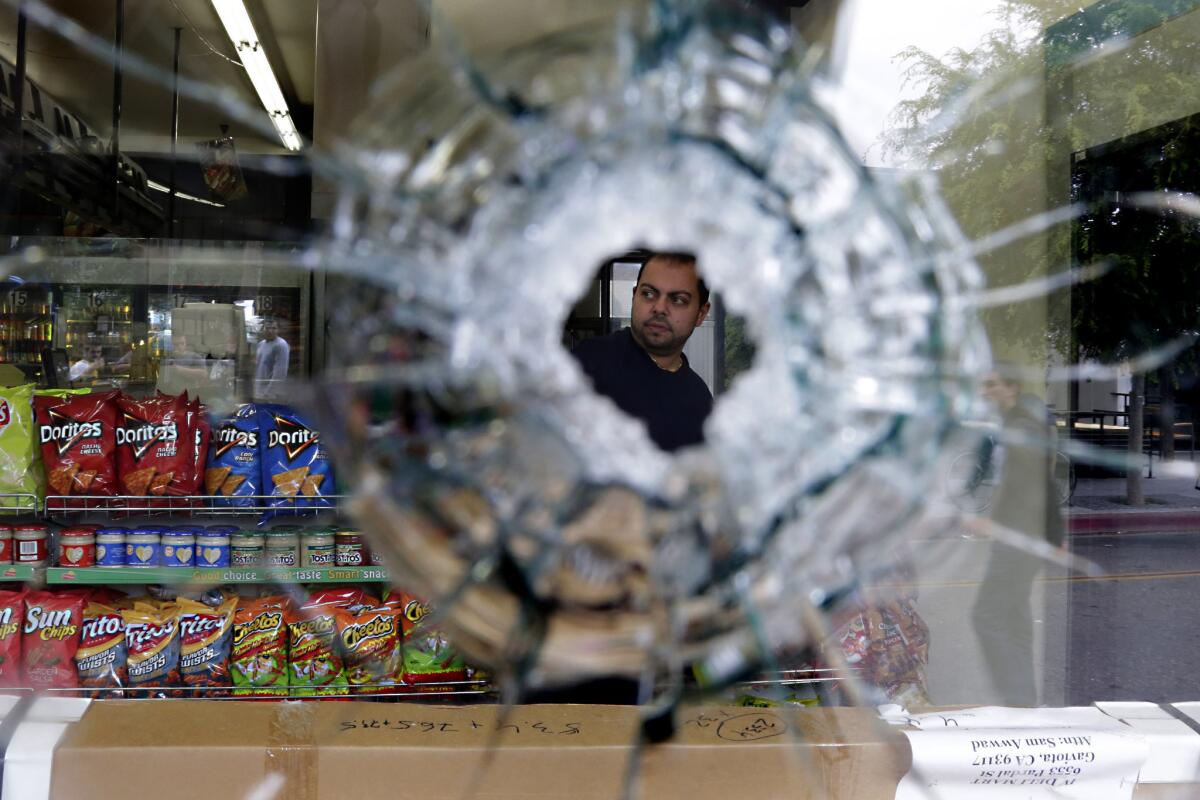A killer’s rampage in Isla Vista

Reporting from ISLA VISTA, Calif. — At first, when it began, it was lost to the soundtrack of another Friday night in this bluff-top college town: screeching tires and what sounded like fireworks.
But then — shattered glass. Sirens. Screams.
Within 10 minutes, it was done — seven dead, 13 wounded, a tormented young man slumped at the wheel of a shattered BMW, a gunshot wound to his head, three semiautomatic handguns and more than 400 rounds of ammunition at his side.
Behind him, there were 10 distinct crime scenes in a single square mile — skateboarders and bikers run down and tossed into the air; bullets bursting through the windows of shops; police officers tackling pedestrians and hauling them indoors to protect them; two young women dying on the lawn of a sorority.
For months, Elliot Rodger, 22, had posed behind the wheel of that same BMW, posting videos of himself on social media.
The son of a Hollywood director, he was born to a rarefied world, but he had been suffocating in sadness and self-pity, lashing out at those he felt had rejected him. To the popular kids, the sorority sisters, “the brutes,” he had promised “a day of retribution.”
On Friday, the authorities said, it arrived. Santa Barbara County Sheriff Bill Brown called the rampage “premeditated mass murder,” the “work of a madman.”
A 137-page diatribe Rodger emailed to an online acquaintance before the killings appeared to shore up those contentions.
In the document, Rodger envisioned a future in which sexuality no longer existed, and women were housed in concentration camps. He pledged to do “everything in my power to destroy everything I cannot have.”
“I am the true victim in all of this,” he added. “I am the good guy. Humanity struck at me first.”
Rodger’s family, through an attorney, released a statement offering its “deepest compassion and sympathy to the families involved in this terrible tragedy.”
“We are experiencing the most inconceivable pain, and our hearts go out to everybody involved,” the family said.
On Saturday, marine clouds clung to the terraced bluffs of Santa Barbara County, creating a drab and eerie tableau. Bleary residents walked quietly through the streets, peering through bullet holes in windows, watching as scores of law enforcement officers combed through the residential neighborhood where the BMW crashed.
The still was punctuated by moments of heartbreak. The father of one victim, 20-year-old Christopher Martinez, collapsed in the arms of a police chaplain after he described how his family was “lost and broken.”
Martinez, a sophomore at UC Santa Barbara, was an English major and planned to attend law school. He was shot and killed when he went to a convenience store for a snack, 45 minutes after speaking with his father on the phone.
“You don’t think it will happen to your child, until it does,” said his father, Richard Martinez.
The elder Martinez lashed out at gun-rights advocates and politicians who won’t stand up to them. He held in his hands a photo of his son as a child, smiling in a baseball uniform.
Elliot Rodger saw numerous therapists, according to his family, and was on the autism spectrum.
He posted videos decrying the “cruelty of humanity” and recently made a “citizen’s arrest” after accusing a roommate of stealing three candles with a value of $22.
Separately, just a month ago, family members asked sheriff’s deputies to check on his welfare. When they arrived, the sheriff said, officers interviewed him and found him to be polite and lucid.
Hidden in his bedroom were handguns Rodger legally purchased from licensed dealers in Goleta, Oxnard and Burbank, authorities said. Investigators also recovered 41 10-round magazines — more than 400 unused bullets — from Rodger’s car.
“They talk about gun rights. What about Chris’ right to live?” Richard Martinez shouted, his shoulders shuddering with grief. “When will this insanity stop? We don’t have to live like this.”
Brown, the Santa Barbara County sheriff, said the violence unfolded like this:
Before his rampage through Isla Vista, Rodger stabbed and killed three people inside his two-story, charcoal-colored apartment building, where he lived in No. 7. It was, the sheriff said, “a horrific crime scene.”
At about 9:30 p.m. Friday, he drove to the Alpha Phi sorority house and banged aggressively on the door.
The events were unfolding just as Rodgers had said in his videos and documents. He would kill people quietly at first, at his home, and then go to a sorority house to “slaughter” women.
“Fortunately, no one opened the door” at the sorority house, the sheriff said. Before leaving the sorority house, however, Rodger shot three women in the front lawn. Two of them, both UCSB students, died. A third survived multiple gunshot wounds.
Rodger then began piloting his BMW through the streets of Isla Vista, an unincorporated community on the coast of Santa Barbara County. Isla Vista is home to about 23,000 people, more than half of them students at the nearby university.
Rodger, who grew up in Calabasas and Woodland Hills, was enrolled at Santa Barbara City College, about 12 miles to the east. He had indicated to authorities that he might not return to school in the fall.
Lyssa Hopper, a 19-year-old student, was at the counter of the I.V. Deli Mart, a convenience store two blocks from his apartment, popular among students for its authentic shawarma and $1 corndogs. This was Rodger’s next stop.
When bullets burst through the windows, Hopper dropped to the ground, looked up and saw a man lying near the door — Christopher Martinez.
“He was slumped over, and he was bleeding,” Hopper said.
“It’s such a tragedy,” said Blake Batson, an assistant manager at the market. “It’s absolute lunacy.”
Manny Rodriguez, 57, was delivering sandwiches down the street when a girl ran from the convenience store screaming. The shooter, Rodriguez said, paused to reload. “The guy unloaded a full clip,” Rodriguez said. “He was shooting fast.”
Rodger drove to “The Loop,” a horseshoe-shaped embarcadero that serves as a hub of the student community. He fired multiple rounds at two people before turning onto a nearby street, authorities said.
Rodger encountered a sheriff’s deputy for the first time; the two exchanged fire. He then ran down a bicyclist and shot four more pedestrians before encountering four sheriff’s deputies, who were running across Little Acorn Park, at the southern tip of The Loop.
Rodger exchanged gunfire with the deputies, none of whom was injured. The deputies shot Rodger’s car and appear to have shot him in the hip. Rodger accelerated on Del Playa Drive, which rests at the rim of the Isla Vista bluff.
He hit another bicyclist, who was thrown onto the hood of the car, caving in the windshield. Rodger caromed off and between several cars before crashing into the back of a jeep and coming to a halt — the car’s airbags deployed, its right front wheel well in flames, its driver’s door thrown open.
Jahangir Siddiqui, a UCSB senior from San Diego, was at home and heard gunshots in the distance — about 30, he estimated. Then, he heard a crash outside his apartment. From his window, he saw the BMW, a hole in its windshield, a mangled bike in the road behind it. Rodger was in the passenger seat. “His body looked limp,” he said.
A single officer ran to the BMW with his weapon drawn, Siddiqui said. Within a minute, a dozen officers swarmed the car. They dragged Rodger’s body from the car and handcuffed him, but he was “obviously dead,” Brown said. “It would appear as though he took his own life.”
Authorities said 11 of the 13 people wounded during the assault required treatment at area hospitals. As of Saturday evening, four had been released, two were listed in good condition, three in fair condition and two in serious.
Eight of the 13 wounds were from gunshots, four from being struck by Rodger’s car and one was of unknown origin.
Attention will focus in coming days on warning signs that might have been noticed by Rodger’s family and by law enforcement.
Brown said his agency had three previous “contacts” with Rodger.
The first came in July 2013, when Rodger was being treated at the hospital for injuries he said he suffered when he’d been assaulted. A responding deputy learned that, in fact, Rodger might have been “the aggressor” in that incident, and the investigation was suspended, the sheriff said.
The second incident came in January 2014, when Rodger made the “citizen’s arrest” of his roommate over the candles.
The third and most significant interchange between Rodger and law enforcement officials came in April, when deputies checked on his welfare.
Rodger’s family had grown disturbed at some of the videos the young man had posted on social media. Brown said that at the time, Rodger “downplayed the concerns for his welfare,” and did not meet the threshold for involuntary mental health counseling.
Only on Saturday, when authorities read the screed that Rodger had passed to an online acquaintance, did they learn how hard he had worked to manipulate the conversation.
“I heard a knock on my apartment door. I opened it to see about seven police officers asking for me,” Rodger wrote. “As soon as I saw those cops, the biggest fear I had ever felt in my life overcame me.”
The fear, he wrote, was that the authorities would find his cache of weapons in his bedroom, along with his written plans for his assault. If so, “I would have been thrown in jail, denied of the chance to exact revenge on my enemies. I can’t imagine a hell darker than that.”
But that didn’t happen, Rodger wrote.
“I tactfully told them that it was all a misunderstanding, and they finally left. If they had demanded to search my room … that would have ended everything,” he said.
“For a few horrible seconds I thought it was all over. When they left, the biggest wave of relief swept over me …. During the last few weeks of my life, I continued my daily adventures around town, trying to experience as much of the world as I could before I die.”
Times staff writers Julie Cart, Amanda Covarrubias and Stephen Ceasar in Isla Vista and Richard Winton, Rong-Gong Lin II, Rosanna Xia, Garrett Therolf, Matt Stevens, Monte Morin and Bob Pool in Los Angeles contributed to this report.
More to Read
Sign up for Essential California
The most important California stories and recommendations in your inbox every morning.
You may occasionally receive promotional content from the Los Angeles Times.













